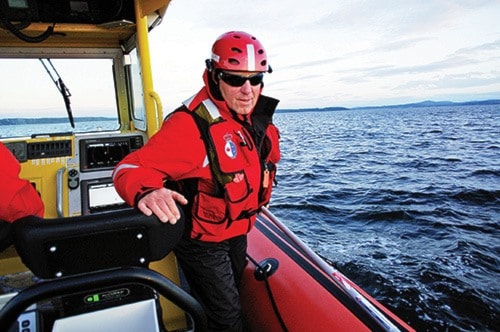When there’s trouble on the water around the Saanich Peninsula, there are volunteers waiting to spring into action to help their neighbours.
As the weather gets warm and days are bright and sunny, more and more people head out on their boats to revel in one of the region’s largest recreational activities. And with 10 marinas from Sidney to North Saanich on the east side of the Peninsula, there could be a lot of vessels on the ocean at any given time. With that many, there are bound to be some conflicts or even an accident or two.
That’s where members of the Saanich Marine Rescue Society come in.
These dedicated volunteers operate the vessel Jack Simpson out of the Canoe Cove Marina 24 hours a day, seven days a week.
“For the boater out there in distress,” says volunteer coxswain Tim Sanderson, “there’s no cost.”
Sanderson and Andrew Abel joined crew chief Bill Chapeskie in starting a week-long evening shift last Thursday night. They met at the unit’s ready room at Canoe Cove to get the boat and their equipment ready for the job. On each shift, day or night, a crew is on call. Many have regular jobs and all must be able to respond quickly in an emergency. Chapeskie said once a call comes in, the standard response time is 15 minutes.
Non-emergency calls will generally take longer, depending on the nature of the incident.
“Call-wise, we do just about everything,” said Chapeskie.
Everything includes assisting people with a tow when their motor goes down or something else breaks, to actual search and rescue emergencies.
“In a code three (emergency), 15 minutes to being on the water is the standard and minimum requirement for those calls,” Chapeskie said. “And call-wise, we’ve seen it all at one time or another.”
This summer has been particularly busy, he continued, as the weather has been very warm for long periods of time. He also said he thinks the economy must be doing a bit better than in recent years, which could also account for more boat owners being on the water.
All of this makes for a busy season.
The unit, Station 36 (Sidney) has already responded to many calls, the most recent of which was a collision between two boats on the evening of Sidney’s Canada Day fireworks. In that incident, said Chapeskie, two children were thrown from one vessel into the water. Their dad jumped in to save them and it was only after he succeeded that he discovered serious back injuries.
Later, a boat was discovered plying local waters without a skipper. A rescue operation was in the early stages when members of the volunteer crew on duty managed to track down the owner, who has failed to tie it securely before falling asleep.
Being able to respond to these and other kinds of calls requires a lot of training. When someone joins their local Marine Rescue Society (there are others in the region, including Brentwood Bay, Oak Bay, Victoria and Esquimalt), Chapeskie said they are given instruction in everything. That includes how to operate the boat, radio and communications procedures, first aid, navigation and much more.
“This work requires specialized courses,” said Chapeskie.
He noted there’s even a simulator available to search and rescue crews. It’s a vessel simulator and while located on land, its hydraulics and screens give users the sensation of being on the water.
“It gives our crews instruction into any situation, like when fog rolls in. You’re practicing for the real thing. Of course, we do that in real life as well.”
The training, Chapeskie said, helps each crew prepare a plan on how to respond in any given circumstance. This ensures the volunteers themselves are safe when they go into an emergency call.
Training also involves other agencies, from the RCMP and military search and rescue, to B.C. Ferries and other private operators. Regular inter-agency training days are held to ensure the volunteers and professionals are familiar with each other and know how to work together in large emergencies.
For volunteers with Sidney Marine Rescue Society, it can be a big commitment. And rewarding, said the crew of the Jack Simpson. Where else better, added Chapeskie, can you be on a hot, sunny day than on a boat on the water?
Currently, the Sidney station has only around 24 volunteers. For a unit that monitors marine incidents 24 hours a day, seven days a week, that can get demanding. That’s why the unit is always looking for new people who are willing to make the commitment. A typical crew, at full capacity is five or six members. These days, they have to man the boat with a minimum of three people at night and tow during the day.
Volunteers must also be willing to help out with ongoing fundraising. Chapeskie noted the unit is funded mostly by individual or corporate donations, as well as through government grants they apply for each year. Donations have ensured the crews stay afloat and have the necessary gear to help people on the water.
To learn more, or to volunteer, visit www.marinerescue.org or send an email to info@marinerescue.org.
editor@peninsulanewsreview.com
